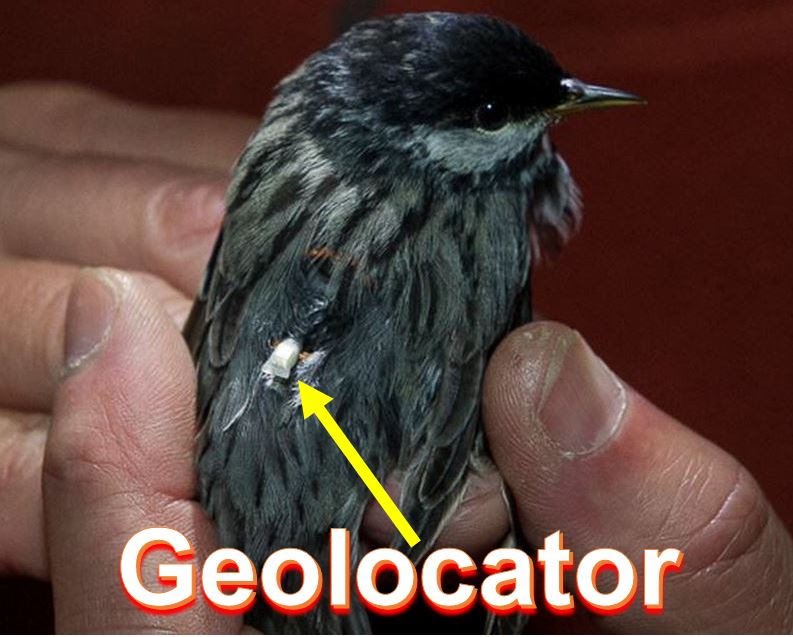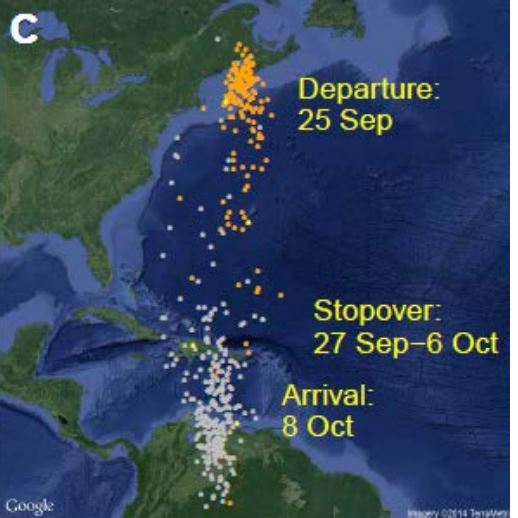A tiny songbird, the 0.42 oz (12 gram) Blackpoll Warbler flies from 1,410 to 1,720 miles (2270 to 2770 km) over the sea non-stop every year in an incredible migration feat scientists describe as “on the brink of impossibility”.
The Blackpoll Warbler, which is smaller than a sparrow and only slightly larger than the British wren (Eurasian wren), was part of an extensive study that monitored the tiny songbird from northeastern North America all the way down to the northeastern coast of South America.
First author Bill DeLuca, an environmental conservation research fellow at the University of Massachusetts Amherst, and colleagues published their findings in the academic journal Biology Letters.

The Blackpoll Warblers had miniaturized light-level geolocators placed on their backs. (Photo: Vermont Center for Ecostudies)
Dr. DeLuca said:
“For small songbirds, we are only just now beginning to understand the migratory routes that connect temperate breeding grounds to tropical wintering areas.”
“We’re really excited to report that this is one of the longest nonstop overwater flights ever recorded for a songbird, and finally confirms what has long been believed to be one of the most extraordinary migratory feats on the planet.”
Mega-feeding before marathon migration
Before embarking on their ultra-marathon fly-or-die flight over the ocean, Blackpoll Warblers eat as much as they can to build up their fat stores, eventually doubling their levels of body mass in fat so that they can fly without having to stop for water or food.
The researchers explain that not much had been known about the migration patterns of smaller birds, mainly because until recently it was impossible to place small enough tracking devices on them.
Since the late 1950s, biologists had hypothesized that the Blackpoll Warbler (Setophaga striata) set off in the fall (autumn) from the north east of North America and flew down to either the Great Antilles in the Caribbean Sea or the northeastern coast of South America.

As the geolocators show, Blackpoll Warblers breed in northeastern North America (orange), and winter (white-grey) in the Caribbean and South America. (Image: Biology Letters)
The Blackpoll Warlbler – an admirable migrator
We have long known that the larger birds, including gulls, sandpipers and albatrosses fly huge distances across the ocean.
A team of researchers from the University of Massachusetts (US), the University of Guelph (Canada), the Vermont Center for Ecostudies (US), the Smithsonian Conservation Biology Institute (US), Acadia University (Canada), and the Long Point Bird Observatory (Canada), attached tiny devices to 20 Blackpoll Warblers in Nova Scotia and another 20 in Vermont.
Their aim was to study the birds’ movements and determine whether this tiny forest dweller really did what the majority of its peers dare not do.
According to tracking data, the birds flew from Nova Scotia or Vermont down to the islands of Puerto Rico and Hispaniola where they stopped to feed and rest. They then crossed the Caribbean Sea towards their winter destinations either in northern Columbia or Venezuela.
The authors wrote:
“The Blackpoll Warbler, a 12 g boreal forest songbird, completes an autumn transoceanic migration ranging from 2270 to 2770 km (mean ± s.d.: 2540 ± 257) and requiring up to 3 days (62 h ± 10) of non-stop flight.”
“This is one of the longest non-stop overwater flights recorded for a songbird and confirms what has long been believed to be one of the most extraordinary migratory feats on the planet.”
To have an idea of the scale between, for example, an Albatross (weighing up to 10 kg) and the Blackpoll Warbler. The Albatross is 833 times heavier. So, weight-for-weight, the Albatross would need to fly 1,249,500 miles non-stop to achieve what the Blackpoll Warbler does, i.e. it would need to fly around the Earth 52 times non-stop.
Reference: William V. DeLuca, Bradley K. Woodworth, Christopher C. Rimmer, Peter P. Marra, Philip D. Taylor, Kent P. McFarland, Stuart A. Mackenzie and D. Ryan Norris. “Transoceanic migration by a 12 g songbird.” Biology Letters. Published 1 April, 2015. DOI: 10.1098/rsbl.2014.1045.

